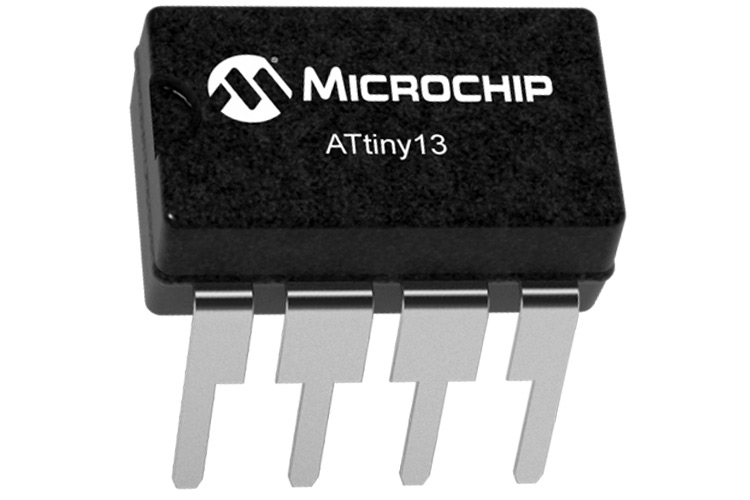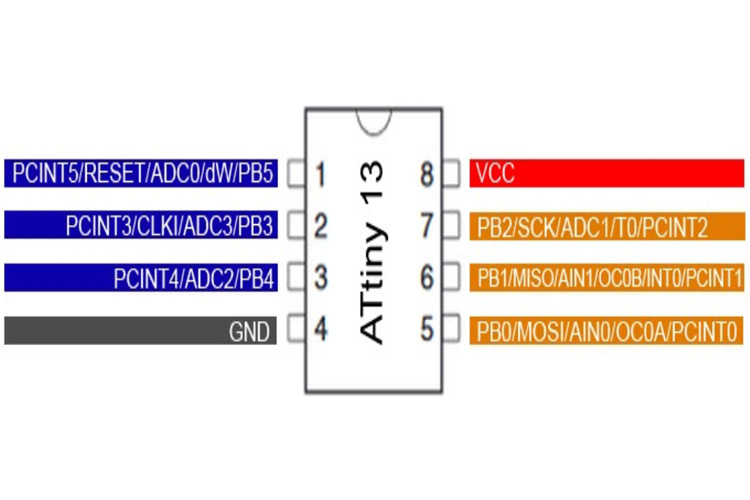ATtiny13 8-bit AVR Microcontroller
ATtiny13 is a high-performance and low power technology 8-bit AVR RISC architecture based Microcontroller unit that has 8 pins out of which 6 pins can be used as I/O pins. It has Powerful instruction architecture that provides a processing speed of 1 MIPS per MHz while balancing power consumption at the same time processing high-speed performance. The speed could reach up to 20 MIPS if 20 Mhz max frequency is used.
ATtiny13 Pin Configuration
|
Pin Number |
Pin Name |
Description |
|
1 |
(PCINT5/RESET/ADC0/dW)PB5 |
Pin of Port B Bit 5 or ADC Input Channel 0 or debugWIRE I/O or Pin change Interrupt 0, source 3 or Reset pin mainly used for programming |
|
2 |
(PCINT3/CLKI/ADC3) PB3 |
Bidirectional I/O Pin of Port B Bit 3 or ADC Input Channel 3 or External Clock Input or Pin change Interrupt 0, source 3 |
|
3 |
(PCINT4/ADC2) PB4 |
Bidirectional I/O Pin of Port B Bit 4 or ADC Input Channel 2 or Pin change Interrupt 0, source 4 |
|
4 |
GND |
Ground Pin of MCU |
|
5 |
PB0 (MOȘI/AIN0/OC0A/PCINT0) |
Bidirectional I/O Pin of Port B Bit 0 or SPI MOSI used for programming or Analog comparator + or Pin change interrupt0, source 0 or Timer/Counter0 compare Match A Out |
|
6 |
PB1 (MISO/AIN1/OC0B/INT0/PCINT1) |
Bidirectional I/O Pin of Port B Bit 1 or Analog comparator input - or External input 0 input or Timer/Counter1 Compare Match B Out or Pin change Interrupt 0, source 1 or SPI MISO used for programming |
|
7 |
PB2 (SCK/ADC1/T0/PCINT2) |
Bidirectional I/O Pin of Port B Bit 2 or ADC Input Channel 1 or Timer/Counter0 Clock Source or Serial Clock input or Pin change Interrupt 0, source 2 or external clock input, used for programming |
|
8 |
VCC |
Positive Pin of MCU (+5V) |
Features and Specifications of the ATtiny13 Microcontroller
|
ATtiny13 - Simplified Features and Specification |
|
|
CPU |
8-bit AVR |
|
Number of Pins |
8 |
|
Operating Voltage (V) |
1.8-5.5V |
|
Number of I/O pins |
6 |
|
ADC Module |
10-bit (4-Channel) |
|
Timer Module |
8-bit(1) |
|
Comparators |
1 |
|
DAC Module |
Nil |
|
Communication Peripherals |
1- SPI |
|
External Oscillator |
Yes |
|
Internal Oscillator |
9.6 MHz |
|
Program Memory (KB) |
1 KB |
|
CPU Speed (MIPS) |
20 MIPS |
|
RAM Bytes |
64 |
|
Data EEPROM |
64 Bytes |
Note: Complete technical details can be found in the ATtiny13 Datasheet, linked at the bottom of this page.
Alternative for ATtiny13
Alternative products for ATtiny13 microcontroller are listed in the below -
- ATtiny2313A (Exact Alternative with the new release)
- ATtiny417
- ATtiny28L
- ATtiny48
- ATmega88PA
- ATmega8A
- ATmega8515
- ATmega8535
- ATmega645A
- ATmega6490
Introduction to ATtiny13
ATtiny13 is a high-performance and low power technology 8-bit AVR RISC architecture based Microcontroller unit that has 8 pins out of which 6 pins can be used as I/O pins. It has Powerful instruction architecture that provides a processing speed of 1 MIPS per MHz while balancing power consumption at the same time processing high-speed performance. The speed could reach up to 20 MIPS if 20 Mhz max frequency is used.
ATtiny13 also comes with the debugWIRE On-Chip debugging feature, In-system Programmable SPI Port, Low-Power Idle, Power-down, and Standby Modes. It also uses a programmable brownout detection circuit.
It has a wide operating voltage range, from 1.8V to 5.5V. Thus, it can be used in 1.8V, 3.3V, or 5.0V logic level operations. However, 0-4 Mhz operation is supported by the 1.8V input voltage for ATtiny13V. For frequency up to 10 Mhz minimum voltage is required 2.7V for ATtiny13, and for 20 Mhz operations, the minimum voltage is required 4.5V-5.5V.
The below image is showing the detailed pin diagram of ATtiny13.

Detailed Specifications of ATtiny13
|
ATtiny13 –Detailed Features |
|
|
CPU |
8-Bit AVR RISC |
|
Architecture |
8 |
|
Program Memory Size (Kbytes) |
1 |
|
RAM (bytes) |
64 |
|
EEPROM/HEF |
64 |
|
Pin Count |
8 |
|
Max. CPU Speed (MHz) |
20 |
|
Peripheral Pin Select (PPS) |
No |
|
Internal Oscillator |
9.6 Mhz |
|
No. Of comparators |
1 |
|
No. Of Operational Amplifier |
0 |
|
No. Of ADC channels |
4 |
|
Max ADC Resolution (bits) |
10bit - 15 ksps |
|
ADC with Computation |
0 |
|
Number of DAC Converter |
0 |
|
Max DAC resolution |
- |
|
Internal Voltage Reference |
No |
|
Zero Cross Detect |
No |
|
No. Of 8-bit timers |
1 |
|
No. Of 16-bit Timers |
0 |
|
Signal Measurement Timer |
0 |
|
Hardware Limit Timer |
0 |
|
No. Of PWM outputs |
2 |
|
Max PWM resolution |
1024 |
|
Angular Timer |
0 |
|
Math Accelerator |
No |
|
No. Of UART module |
0 |
|
No. Of SPI Module |
1 |
|
No. Of I2C module |
0 |
|
No. Of USB Module |
0 |
|
Windowed Watchdog Timer (WWDT) |
No |
|
CRC/Scan |
No |
|
Numerically Controlled Oscillator |
No |
|
Cap. Touch Channels |
6 |
|
Segment LCD |
0 |
|
Minimum Operating Temperature (*C) |
-40 |
|
Maximum Operating Temperature (*C) |
85 |
|
Minimum Operating Voltage (V) |
1.8 / (2.7 up to 10 Mhz) / (4.5 up to 20 Mhz) |
|
Maximum Operating Voltage (V) |
5.5 |
|
High Voltage Capable |
No |
Programming AVR Microcontroller
AVR microcontrollers can be programmed with different software that is available in the market. There are people who still use Assembly language to program AVR MCUs. The below details is for the most advanced and common software and compiler that has been developed by Atmel (now Microchip) itself.
In order to program the AVR microcontroller, we will need an IDE (Integrated Development Environment), where the programming takes place. A compiler, where our program gets converted into MCU readable form called HEX files.
IDE: Atmel Studio 7
Compiler: AVR and ARM Toolchains
Microchip has given all these two software for free. They can be downloaded directly from their official page. I have also provided the link for your convenience. Once downloaded install them on your computer. If you have any problem doing so you can post them on the comment below.
To dump or upload our code into AVR, we will need a device called ATAtmel-ICE. The ATAATmel - ICE programmer/debugger is a simple, in-circuit debugger that is controlled by a PC running Atmel Studio software on a Windows platform. The ATAAtmel-ICE programmer/debugger is an integral part of the development engineer's tool suite. The ATtiny13 Programming Circuit is shown below.

Other than this official programmer, users also use USB ASP AVR Programming Device for low-cost programming solutions. In addition to this, we will also need other hardware like a Perf board or breadboard, Soldering station, AVR ICs, Crystal oscillators, capacitors, etc.
Components Associated ATtiny13 Microcontroller
USB ASP AVR Programmer, AVR Development Board, Crystal Oscillators, Capacitors, 12V Adapter, 7805 Voltage Regulator.
2D Model
The dimensions of the ATtiny13 are shown below -












